#annual concert review
Explore tagged Tumblr posts
Text
[ENG SUB] Bojan Cvjetićanin with Slovene Police Orchestra (02.12.2024)
On December 2nd 2024, Bojan performed with the Slovene Police Orchestra at their annual concert for the 'Slovenija piha 0,0' campaign ('Slovenia blows 0.0', referring to breathalyzer tests), which promotes no drinking when driving.
The original video can be found here.
Transcript, translation and subtitles by a member of JokerOutSubs, review by drumbeat, proofread by IG GBoleyn123.
🇷🇸 Serbian translation by IG marija_rocen.
Full video on our YouTube!
youtube
#joker out#jokeroutsubs#bojan cvjetićanin#bojan cvjeticanin#jan peteh#nace jordan#kris guštin#kris gustin#jure macek#jure maček#Youtube#type: video#jo: bojan solo#year: 2024#og language: slovenian#source: slovenjia piha nula nula
39 notes
·
View notes
Text




─ •✧ CATHERINE'S YEAR IN REVIEW : 𝐒𝐄𝐏𝐓𝐄𝐌𝐁𝐄𝐑 ✧• ─

𝟑 𝐒𝐄𝐏𝐓𝐄𝐌𝐁𝐄𝐑 : Catherine and William were spotted at White Waltham Airfield for George's flight lessons. Later, they spent time at the West London Aero Club.
𝟔 𝐒𝐄𝐏𝐓𝐄𝐌𝐁𝐄𝐑 : Catherine released a personal statement welcoming new UK Chief Scout Dwayne Fields FRGS.
𝟗 𝐒𝐄𝐏𝐓𝐄𝐌𝐁𝐄𝐑 : The Princess of Wales released a video by Will Warr and a series of photographs accompanied by a statement announcing the successful end of her cancer treatment & that she was in remission, however, she will be continuing her recovery.
𝟏𝟑 𝐒𝐄𝐏𝐓𝐄𝐌𝐁𝐄𝐑 : WillCat made a private donation to Pecan charity in aid of their recovery efforts following the theft food supplies from Southwark Foodbank.
𝟏𝟕 𝐒𝐄𝐏𝐓𝐄𝐌𝐁𝐄𝐑 : Catherine held an Early Years Meeting. This was the first official meeting that the Princess undertook sincerely the beginning of her cancer treatment.
𝟐𝟐 𝐒𝐄𝐏𝐓𝐄𝐌𝐁𝐄𝐑 : Catherine and William attended the Divine Service held in Crathie Parish Church. They spent a private Weekend in Balmoral.
𝟐𝟒 𝐒𝐄𝐏𝐓𝐄𝐌𝐁𝐄𝐑 : She held a Meeting at Windsor Castle for her annual Christmas Concert.
𝟐𝟔 𝐒𝐄𝐏𝐓𝐄𝐌𝐁𝐄𝐑 : Catherine attended a matinee performance of Akram Khan’s Giselle at Sadler Wells and sent a personal tweet congratulating the cast and crew. Catherine's unseen photograph with the Middletons was released as part of James Middleton's book 'Meet Ella'.

#year in review : 2024#review 2024#year in review 2024 : catherine#review september#year in review : catherine#catherine review : september#year in review 2024 : september#princess of wales#the princess of wales#princess catherine#catherine princess of wales#princess kate#prince george#princess charlotte#prince louis#prince of wales#the prince of wales#prince william#william prince of wales#brf#british royal family#british royalty#royal family#british royals#royalty#royals#royal#kate middleton#royaltyedit#royalty edit
36 notes
·
View notes
Text
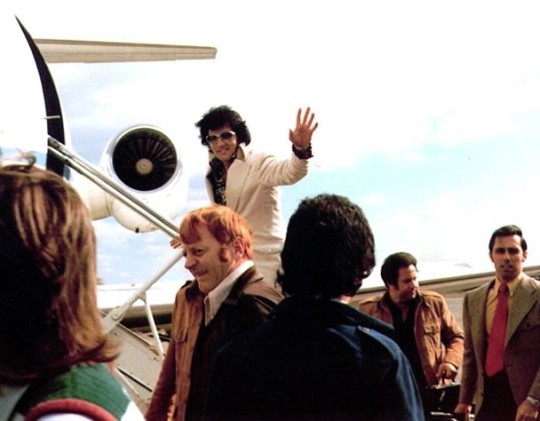
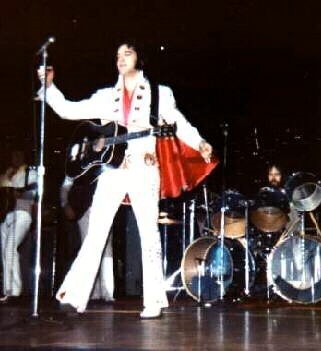
Events In The History And Of The Life Of Elvis Presley Today On The 12th Of November In 1972
Elvis Presley Tour And Show Comes To San Bernardino CA.
A look back at Elvis Presley's 1972 outstanding concert at swing auditorium in San Bernardino CA
Sunday night, Nov. 12, 1972. The Santa Ana winds were howling, so typical of San Bernardino in November. And it was cold. But a sold-out crowd stood patiently to have an audience with The Legend . Elvis Presley was in the Swing Auditorium.
The Swing was the place east of L.A.'s Fabulous Forum to see virtually every top name act in the rock world, circa 1964 through 1981. Located on E Street, the auditorium was built in 1949 on the grounds of the National Orange Show and was named for Senator Ralph E. Swing, a San Bernardino legislator. What a glorious barn it was and what history played out on that stage. The Rolling Stones did their first American concert there in June 1964. The place rocked until a small plane crashed into it on Sept. 11, 1981 and the auditorium had to be demolished. One of the last shows played there featured Iron Maiden.
In between, rock royalty were regulars. Fleetwood Mac played more than five times. The Byrds, Buffalo Springfield, Jefferson Airplane, Creedence Clearwater Revival, Cream, Jimi Hendrix Experience, Led Zeppelin, The Doors, Black Sabbath, Ramones (as opening act), Chicago, Jethro Tull, Alice Cooper, the Grateful Dead (multiple times), Faces with Rod Stewart (also multiple times), Santana, the Kinks, Janis Joplin, Eric Clapton, the Beach Boys, and more. Look up how many of these acts are in the Rock and Roll Hall of Fame. Just about everybody but the Beatles made it to the Swing.
Prior to the modern rock era, Bob Hope was almost an annual fixture at the Swing during the National Orange Show Fair. Other notables who performed there in the '50s and '60s included Sammy Davis Jr., Jack Benny, Judy Garland, Jerry Lewis, and George Burns. But never had a King played there before that night.
Yet, it wasn't as if Elvis Presley had never been to the IE. He did own a house for several of the Priscilla years in Palm Springs and was known to do some boating in Big Bear Lake. Many scenes of the totally forgettable remake movie 'Kid Galahad' were shot in Idyllwild. And, some of the outdoor footage in 1964's 'Kissin' Cousins' was shot in the San Bernardino Mountains. Still, this was different.
Elvis Presley's nationwide tour began at Madison Square Garden in New York, a city he had never before performed live in. The four concerts there were sold out and got rave reviews. At 37, he was 'lean, tanned and greasily handsome, his coal-black hair glistening with an oily 1950s sheen', as the New York Times' Grace Lichtenstein put it. At a press conference before the Madison Square Garden appearance, he was asked about the secret of his longevity on the pop music scene. 'I take Vitamin E', he told reporters.
From New York, the tour moved west, passing through cities like Milwaukee, Chicago, Wichita and Tulsa before continuing on to Las Vegas. Elvis stayed there for most of October before continuing the tour, which took him to Texas, Arizona, and into California. He hit Oakland, then San Bernardino, where he performed two sold-out shows - one on Nov. 12 and another on Nov. 13. rom there, he headed to the Long Beach Arena for two shows, the last stop before catching a plane for Honolulu where the tour would wrap up. Originally, the Honolulu show was planned to be broadcast worldwide by satellite, but the broadcast date was changed to early 1973 so it wouldn't conflict with the release of MGM's musical documentary Elvis on Tour. No matter. The show (actually four of them) went on. And in Honolulu, as well as in other cities on the tour, fans of all ages crowded concert venues to get a live view of the King.
So it was in San Bernardino. The Swing could hold about 10,000 people with a concert take of around $60,000. On that cold November night, fans crammed into the sold-out auditorium. With reserved seating, there was none of the festival seating chaos that marked the Swing rock shows - kids pushing and shoving and fighting to get to the stage area. This crowd was real diferent. I was way too young at 21. For the usual Swing rock show, most of the concertgoers were my age or younger. The guys had long hair, wore boots, Levis and denim work shirts (think the cover of a Creedence album.) The girls went braless, wore tight jeans or peasant dresses. There were always more guys than girls.
For Elvis Presley though, these fans had jobs, mortgages, and kids. The women clearly outnumbered the guys. They wore bright yellow or orange dresses, lots of makeup. Hairspray was huge. And, there were more than a few suicide blondes with hot pants and go-go boots. (I would never have sat on anything in the Swing in hot pants.) Jean Naté was locked in mortal combat with Charlie in a fragrance war. My Sin perfume held its own. Smoke from the bathrooms came from real Marlboro men (and women.)
My seat was in the cheap section - off to the side and high up, close to the glued-on tinsel that was a prominent feature of the Swing. The place always had a peculiar smell. Close to show time, greedy Colonel Tom's minions were at the stage hawking T-shirts, photos, and other assorted gee-gaws. I wonder just how much of that cash Elvis Presley received.
Finally, the lights lowered. The band started playing the theme from 2001: A Space Odyssey. Then, there he was - The King. He was resplendent in a black and red concert suit.
Though his show was typical of his Vegas show that he performed at the International Hotel (later known as the Las Vegas Hilton and now called the Westgate Las Vegas Resort & Casino), it didn't matter to his loyal subjects. He was live in San Berdoo! Old ladies screamed. It was hard to tell from my cheap seat, but I believe there were a few panties thrown at him.
His voice and physique were in A-plus form. He ripped through concert standards such as 'Polk Salad Annie', crooned to crowd favorite 'Can't Help Falling In Love', and did a couple of religious numbers with the gospel group J.D. Sumner and The Stamps.
No Elvis Presley show would be complete without the hits 'Hound Dog', 'All Shook Up', 'Jailhouse Rock', and 'American Trilogy'.
His band and entourage - the Sweet Inspirations, legendary guitar hero James Burton - provided a full sound that could not be duplicated by the typical four-man rock act. It was a show truly becoming of a King. The crowd responded as if seeing him for the first time. Bedlam broke out among the thousands of fans.
After about 90 minutes, despite fans calling for more, Elvis Presley left the auditorium for the San Bernardino Hilton, about $60,000 richer. I was a poor college kid. I went to Del Taco. What a Sunday night! rare candid photo's one captured of elvis presley leaving Oakland CA captured here by a female ep fan boarding is executive chartered jet heading to San Bernardino CA and performing here at this show wearing the white pinwheel jumpsuit and the white cape and the lions head belt captured by a fan audience member who was at this show concert.
20 notes
·
View notes
Text




July 24, 1977
Love Gun Tour
Pacific Coliseum - Vancouver, British Columbia
According to the promoter: “The cops heard of KIϟϟ’ so-called reputation and they ordered four squads to the show. They played poker all night and billed us $8,000 for overtime” (Montreal Gazette, 8/2/77).
From a local review: “Hype? Not really. KIϟϟ promise nothing less than the greatest spectacle in rock and nothing less is exactly what they provide. From that it is easy for the unaware parent or pundit to mistake KIϟϟ for a threat to our civilized way of life. But understand this, KIϟϟ are not self-pitying, humorless nihilists like the punk rockers. If anything, they are a fantasy for an age that has seen just about everything. Of course they appeal to the escapist stripe. It would be fun to stand seven feet tall, spit fire, deafen everyone within a 1,000 yard radius and make a million bucks doing it” (Vancouver Sun, 7/25/77).
From another local review: “The KIϟϟ concert Sunday night was better than the fireworks display the Sea Festival holds annually. The Coliseum took on all the aspects of kid’s day at the PNE’s Playland with harried parents leading offspring by the hand up into the stands, plopping their plump selves down into the same seats they had at The Ice Capades or The Shriner Circus, and stopping up their ears with cotton… KIϟϟ was perfunctory as you please, well rehearsed, but musically deadening and the sound from the press box was, as usual, muddy except when Ace Frehley took off into one of his solos. Frehley appeared to be bored, or tired, or sick, or drunk, or all four, while batman, Gene Simmons and Paul Stanley did their best to whip up a surprisingly complacent audience which eventually succumbed and went nuts when the hits and the gimmickry got into gear” (Georgia Straight, 7/28/77)
#kisstory#kiss#1977#love gun#ace frehley#peter criss#paul stanley#gene simmons#kiss band#kiss army#the spaceman#the starchild#the catman#the demon#35 notes#Jul 24th#2022
34 notes
·
View notes
Text
On this day... - July 27th
+ 1969 : Gold Creek Park in Woodinville, Washington, USA
“More than 50,000 rock fans gathered at Woodinville’s Gold Creek Park over the weekend for a practically non-stop three-day festival of music, events and exhibitions. The first annual Seattle Pop Festival was a marvel of crowd control and smooth organization. Sunday night was supposed to belong to The Doors but it was stolen right out from under them by the great English blues group, Led Zeppelin. Coming onstage about 11:30pm, immediately after the forced extravaganza of The Doors, the Zeppelin faced a jaded and uncomfortable audience that had been standing in the cold all evening. But the electricity of lead singer Robert Plant and guitarist Jimmy Page quickly warmed them up.” review by P. Macdonald (Seattle Post – Intelligencer)
+ 1973 : Madison Square Garden in New York, New York, USA



“I saw the Friday opening of the Led Zeppelin concert from backstage, feeling the weight and response of the packed Madison Square Garden. It was possibly the best place to test the power of the British rock group, making the final dates of its current and very successful American tour. And power it is – Led Zeppelin provides a kind of tent-show hard rock revivalism, healing and providing succour to the faithful. […] Led Zeppelin remains unchanged. The group may perform different pieces, but the effect is the same.” – ‘Led Zeppelin rocks to a close at Garden’ (New York Times)
#on this day#led zeppelin#robert plant#jimmy page#john paul jones#john bonham#classic rock#ourshadowstallerthanoursoul
28 notes
·
View notes
Text
How can a music band impact the local Economy
For this topic, the first band to come to my mind was BTS. They’ve been an important part of my teenage years and I got the opportunity to see their influence drastically grow over time.
All of the members are Korean, speak Korean and sing in Korean, but still, they somehow reached fans all around the world. The diversity of a music fanbase has always intrigued me – all those differences came together to form a universal entity.
So I decided to explore one of the maaany points part of this idea. I wanted it to be quite concrete to be able to provide statistics
Quick introduction, BTS is one of the most popular bands of the world. Their music has significantly contributed to South Korea's economy. The band debuted in 2013 but they started to gain an international popularity between late 2015 and 2016. Just like many other artists they’ve inevitably become a symbol of "soft power" and drove global interest in Korean culture.
According to a study published by Hyundai Research Institute, BTS contributes around $3.6 billion annually to the South Korean economy, comparable to the 2018 Winter Olympics, which is undoubtedly a huge number for a single band (I did not find any other Korean band’s statistics to compare with :/).
The members are said to contribute indirectly to the exports in multiple industries such as clothing, beauty or even food industry. The impact can be estimated to reach about 1% in those industries.
But the most obvious contribution is tourism. It’s estimated that they draw approximately 800 000 tourists to South Korea per year, making it roughly 7.6% of total tourist visits.
Another concrete example is the "Magic Shop" concerts in Busan and Seoul in 2019. That year, those concerts made up 1.6% of Busan’s GDP and 0.9% of Seoul’s. (Borgen Magazine/McGill Business Review)
Of course Korean music was already popular at the time thanks to various bands from the ‘2nd generation’, but it remained mostly popular in Asia. BTS’s debut was a turning point for this industry.

13 notes
·
View notes
Text
241208 Sumi Jo Annual Christmas Concert Recording Review
*the audience signed a nda before the performance so no one could take videos or photos of the event!
■ ONEW didn't cut his hair, and today, it was curled. He also looked like a prince because of the white jacket he was wearing (source i ii)

it was similar to this Kira Kira performance ^ but with longer hair and bangs! (source)
■ He actually only sang two songs ('An Island Baby' and 'Snowflake'), the other songs were just sang by the choir! His voice was particularly gentle when he sang 'Snowflake' (source i ii) ONEW had his eyes closed when he was singing (source)
11 notes
·
View notes
Text
The deadly New Year’s Day terrorist attacks in New Orleans and Las Vegas have brought renewed attention to the scourge of extremism in the US military, but efforts to tackle it wilted in the later years of the Biden administration, and are unlikely to be revived once Donald Trump begins his second term this month.
Both the New Orleans vehicle attack that killed 14, and the explosion of a Tesla Cybertruck outside a Trump hotel in Las Vegas in which the driver died, were perpetrated by discharged or serving members of the armed forces.
Though investigators have yet to officially link the events, they follow a pattern of active or veteran military personnel involvement in acts of domestic terrorism, including the 6 January 2021 Capitol riot; a white supremacist rally in Charlottesville, Virginia, in 2017; and the 2009 mass shooting at the former Fort Hood army base in Texas that killed 13.
In response to the series of deadly events, defense secretary Lloyd Austin promised to tackle longstanding failures by the US military to address the problem. In 2021 he announced a series of initiatives, including a working group to study white nationalism and other extremist behavior within the defense department, and the commissioning of an independent report to review the issue and make recommendations.
The efforts, however, fizzled. Congressional Republicans effectively killed the Countering Extremism Working Group in December 2023, starving it of funds in the annual defense authorization bill, months after CNN reported the Pentagon group had “vanished virtually without a trace” because of what analysts said was a concerted Republican “war on woke”.
Its demise, which was never publicly announced, came just weeks after the publication of a report to Congress by the inspector general of the US defense department that detailed 183 investigations of alleged extremism within military ranks.
Dozens of the investigations involved allegations of military members advocating, engaging in or supporting terrorism in the US or overseas, while 14 army investigations related to “advocating or engaging in unlawful force or violence to achieve goals that are political, religious, discriminatory, or ideological in nature”.
The independent report that Austin commissioned, by the Virginia-based Institute for Defense Analyses (IDA), was eventually published in December 2023, 18 months behind schedule, and quickly became the subject of controversy.
It found “no evidence that the number of violent extremists in the military is disproportionate to the number of violent extremists in the US as a whole”, and “no evidence of violent extremist behavior by department of defense civilians”.
Republicans seized on the report as “proof” that the media had colluded with Democrats to create a false narrative about the existence of extremism in the military, while the Republican bloc of the House armed services committee posted to X, then known as Twitter, that Joe Biden had “wrongly targeted our servicemembers with a divisive and political witchhunt”.
But in a November 2024 investigation, the Associated Press found that the IDA report included data two years out of date, “grossly undercounted” the number of serving military and veterans arrested for the 6 January attack, and “provided a misleading picture of the severity of the growing problem” of military extremism, the AP said.
An IDA spokesperson said its report was delivered to the defense department in June 2022. “IDA stands behind the rigor of the analysis and remains confident that the findings, including with regard to the prevalence of violent extremism in the DoD, were solidly based on the best data available at the time the work was conducted,” the group said in a statement.
The defense department did not respond to a request for comment.
Heidi Beirich, chief strategy officer and co-founder of the Global Project Against Hate and Extremism, said the Biden administration began with good intentions to tackle extremism in US military ranks, and made progress in several areas, but was ultimately unable to deliver verifiable progress.
“There were positives, introducing a tattoo database to screen recruits, and tightening up the security clearance process. They created a definition for extremism, and regulations in the army, marines and navy to ban fundraising for, or liking extremist groups on social media,” she said.
“But the issue is enforcement. We have no idea if these things are getting done, how many people have been sanctioned for these things? We don’t have good data from inside the DoD, we have no good information, really, about levels of extremism within the military.”
Beirich said the issue became “a political football” for Republicans, and that she feared the situation would become worse if Pete Hegseth, Trump’s controversial nominee for defense secretary, was confirmed.
“They started having conversations about how you’re smearing the military when you even talk about extremism, which is most evident with Hegseth saying that rooting out extremists is essentially a scam, or some kind of woke,” she said.
“It’s depressing that this problem looks like it’s not going to be taken seriously, and we’re probably going to have more incidents of terrorism from veterans or active duty. The American public is going to be more at risk.”
Other analysts say that tackling the issue is not just the responsibility of the defense department.
“A lot of the individuals who commit these acts are primarily veterans, and often honorably discharged,” said Matt Dallek, a political history professor at George Washington University and author of Birchers: How the John Birch Society Radicalized the American Right.
“The question is how does the government, particularly the Department of Veterans Affairs, try to prevent this sort of radicalization? How do they address the wider problems and challenges that veterans face, access to healthcare, mental health care, readjusting to civilian society and finding gainful employment?
“Although many of these cases may be different, it’s perhaps not all that surprising that a couple of decades post 9/11, a couple of decades of US war in Afghanistan and Iraq, we’re seeing at least some of these incidents of radical association, maybe anger at the US government and military, anger at the way the wars were conducted.”
5 notes
·
View notes
Text
instagram
africanarchives
Fisk University opened in Nashville in 1866 as the first American university to offer a liberal arts education to “young men and women irrespective of color.” 5 years later the school was in dire financial straits.
George L. White, Fisk treasurer and music professor then, created a 9 member choral ensemble of students and took it on tour to earn money for the University. Every one of these students had been enslaved. The group left campus on October 6, 1871. Jubilee Day is celebrated annually on October 6 to commemorate this historic day.
The first concerts were in small towns. Surprise, curiosity, and some hostility were the early audience response to these young black singers who did not perform in the traditional “minstrel fashion.”
One early concert in Cincinnati brought in $50, which was promptly donated to victims of the notorious 1871 fire in Chicago. When they reached Columbus, the next city on tour, the students were physically and emotionally drained. Mr. White, in a gesture of hope and encouragement, named them “The Jubilee Singers,” a Biblical reference to the year of Jubilee in the Book of Leviticus, Chapter 25.
Continued perseverance & beautiful voices began to change attitudes among the predominantly white audiences. Eventually skepticism was replaced by standing ovations and critical praise in reviews. Gradually they earned enough money to cover expenses and send back to Fisk.
In 1872 they sang at the World Peace Festival in Boston and at the end of the year President Ulysses S. Grant invited them to perform at the White House.
In 1873 the group grew to eleven members and toured Europe for the first time. Funds raised that year were used to construct the school’s first permanent building, Jubilee Hall. Today Jubilee Hall, designated a National Historic Landmark by the US Department of Interior in 1975, is one of the oldest structures on campus. The beautiful Victorian Gothic building houses a floor-to-ceiling portrait of the original Jubilee Singers, commissioned by Queen Victoria during the 1873 tour as a gift from England to Fisk.
🖋️if you love our content, please consider supporting our page on www.AfricanArchives.Support —link in BIO-
3 notes
·
View notes
Text
Andrew Bird & Mary Lattimore Live Show Review: 12/5, Fourth Presbyterian Church, Chicago
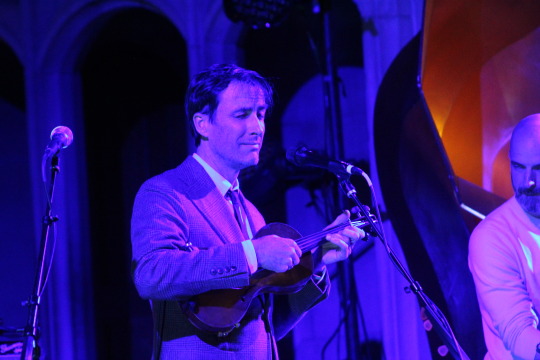
Andrew Bird & Alan Hampton
BY JORDAN MAINZER
A few songs into this year's first Gezelligheid show--Andrew Bird's annual series of winter concerts at the Fourth Presbyterian Church--Bird mentioned that when he put on an Ella Fitzgerald recording when spending time with his family, his niece asked, "Why are you playing Christmas music?" To her, Bird posited, all old music sounded like Christmas music. It's a fairly easy misconception to understand. After all, the feelings you most associate with Christmas, holiday, or wintertime music in general--warmth, joy, familiarity--are often inherent qualities of songs that clearly are from a distant past. A great classic song can make you feel nostalgia for a time you didn't even experience. It's that phenomenon that Bird took advantage of most on Thursday night.
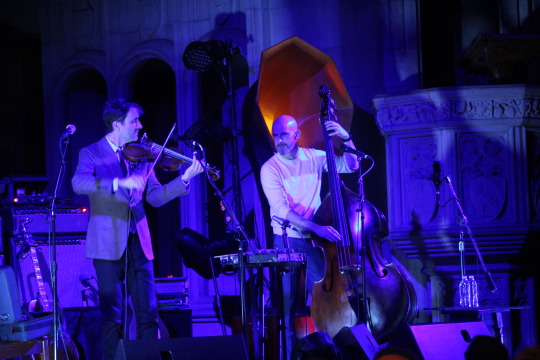
Bird & Hampton
Accompanied by multi-instrumentalist Alan Hampton, Bird played both original and cover favorites from his recorded catalog. Highlights of the former included Armchair Apocrypha's plucky "Plasticities", the minimal "Pulaski at Night", and the swaying "Alabaster" from holiday album Hark! He culled multiple times from his deep well of tunes by Vince Guaraldi and beloved Americana duo The Handsome Family. Midway through the main set, Bird took advantage of returning home and invited Evanston-based longtime collaborator Nora O'Connor on stage. Though O'Connor has long been a backing vocalist for the likes of Bird, The New Pornographers, and The Decemberists, she and Bird actually played a deep cut she recorded with him, a version of Bob Dylan's "Oh Sister" from Bird's 2007 Soldier On EP. The three musicians on stage broke the song down, a capella style, before Bird built it back up with his violin.

Bird
But it was Bird's most recent releases of covers that ended up perfectly encapsulating the allure of the past. In May, he shared Sunday Morning Put-On (Loma Vista) with the trio of Hampton and drummer Ted Poor, a collection of jazz standards (plus one original) interpreted through Bird's unmistakable aesthetic. Bird knows that stringed instruments best emulate human voice, but on Sunday Morning Put-On, he explores the extent to which applying bow pressure on his violin strings can recall the rich sounds that result from blowing air into the mouthpiece of a horn instrument. Early in his set on Thursday, Bird and Hampton performed the Trio's rendition of Johnny Green and Edward Heyman's "I Cover the Waterfront", a song that's been recorded by the likes of Sarah Vaughan and Billie Holiday. Starting with violin, Bird's fluttering followed the original's vocal line; by the time he started singing, his bowing undulated like a tenor saxophone. The performance was eerie, uncanny, and time-bending.

Bird & Hampton
In October, Bird and singer-songwriter Madison Cunningham released Cunningham Bird (Loma Vista), a track-by-track recreation of Lindsey Buckingham and Stevie Nicks' pre-Fleetwood Mac record Buckingham Nicks. For many in the crowd, even among the pop music aficionados, it was their first time hearing the songs at all: Remarkably, Buckingham Nicks is long out-of-print and not on any streaming services, save for some unofficial uploads to YouTube. Bird and O'Connor duetted a strummed, stripped-down, faster-paced version of "Races are Run". On both Cunningham Bird and on Thursday, for "Crystal", Bird inverted the gender of the lead singer, Cunningham and O'Connor, respectively, singing Buckingham's words, Bird harmonizing Nicks' parts. And there's a fun connection between Sunday Morning Put-On and Cunningham Bird, which is John Lewis' "Django", a song that not only did Bird and his Trio cover on the former but that Buckingham and Nicks covered for their album--meaning Bird also reinterpreted Buckingham and Nicks reinterpreting jazz. The version that led into "Races are Run" Bird played on Thursday was firmly the Cunningham Bird version--after all, Poor's drums are key on Sunday Morning Put-On--but the song's inclusion as a standard that can be adapted in many different ways underscored the very concept of Gezelligheid: conviviality, coziness, fun.
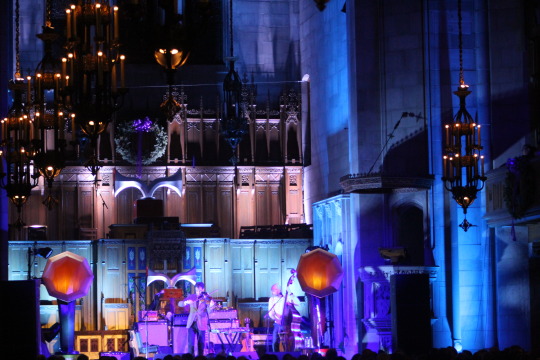
Bird & Hampton
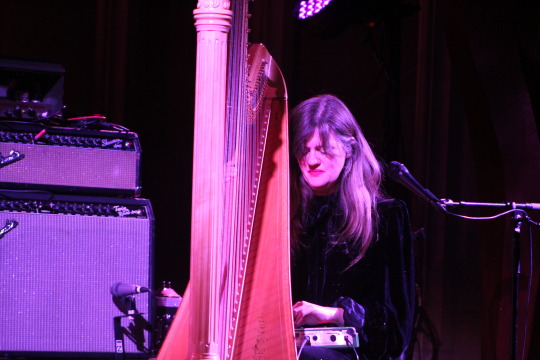
Mary Lattimore
Opening for Bird was harpist Mary Lattimore, a musician who has demonstrated over the past several years that combining classical training with clear experimentation and a sense of humor can, too, result in something fun and beautiful. Lattimore, gifted her harp by Chicago-based factory Lyon & Healy, performed tracks from her dense back catalog, many of which had a story associated with them. She wrote Hundreds of Days' "On the Day You Saw the Dead Whale" after, yes, seeing a dead whale in a coastal California town where she was at a residency. "Wawa By The Ocean", included on her 2017 Collected Pieces compilation, was inspired by her holy routine of buying a hoagie from the Philadelphia-born convenience store/gas station chain and eating it on the Jersey Shore. (Upon finding out about the song, Wawa headquarters sent Lattimore a care package.) "Til a Mermaid Drags You Under" aims to reflect the duality of dark and light in the surf town where it was recorded with Slowdive guitarist Neal Halstead, for 2020's Silver Ladders. On Thursday, hearing the songs' contexts gave crowd members a starting point, either as a lens through which to take in the song or as a challenge to see if they could empty their heads and get lost in the pure sounds emanating from the stage. Lattimore, meanwhile, used synths and looping not to trick and lull you into layers, but to show you how she was manipulating the sounds in real-time, as tangible as her plucks and scratches of the harp. At one point, during Hundreds of Days standout "It Feels Like Floating", ambulances were outside driving down the street, sirens on, but the crowd was subsumed by Lattimore's playing. The harp didn't drown anything out by volume, but like Bird's violin would do later, it enraptured a group of people who had walked through the doors of the church to nestle in the safety of memory and imagination.

Lattimore

Lattimore
#andrew bird#mary lattimore#live music#fourth presbyterian church#jam productions#metro#nora o'connor#sunday morning put-on#alan hampton#gezelligheid#ella fitzgerald#christmas music#armchair apocrypha#hark!#vince guaraldi#vince guaraldi trio#the handsome family#the new pornographers#the decemberists#bob dylan#soldier on#loma vista#loma vista recordings#ted poor#johnny green#edward heyman#sarah vaughan#billie holiday#madison cunningham#cunningham bird
2 notes
·
View notes
Text


Elton John and Bernie Taupin, Gershwin Prize Concert, Constitution Hall, Washington, DC, 20 March 2024. Upper photo: Elton John with Librarian of Congress Carla Hayden. Lower photo John with Bernie Taupin leaning on the piano.
Yesterday was an eclectic one for music. In order to make reviewing a pile of income tax documents tolerable, I queued a playlist of recordings that had been lost in the depths of the CD cupboard and only recently copied to the iMac. The list began with some 12th and 13th century Spanish music by the group Alia Música. That was followed by a recording of Beethoven’s Christus am ölberge, a Haydn symphony, some show tunes by the Tin Pan Alley tummler Leonard Bernstein, and the first of two CDS of Bach’s Johannes-Passion (listening to the second disc as I write this). After an early dinner it was off to Constitution Hall for the Gershwin Prize tribute concert for Elton John and Bernie Taupin. Staged by the Library of Congress annually to honor winners of the Gershwin Prize, the 2024 concert included performances by, among others, Metallica, Annie Lennox, Brandi Carlisle, Garth Brooks, and, amazing as it sounds, Joni Mitchell. The musical day concluded with a performance by the overweight and crippled Elton John who despite health challenges is still a master of the rock piano.
#music#concert#gershwin prize#elton john#bernie taupin#constitution hall#washington dc#2024#photographers on tumblr
7 notes
·
View notes
Text



─ •✧ CATHERINE'S YEAR IN REVIEW : DECEMBER ✧• ─
1 DECEMBER - Catherine visited the sets of Strictly Come Dancing along with Charlotte and Louis. 5 DECEMBER - The Princess of Wales was received by Colonel Jane Davis (Vice Lord-Lieutenant of Greater London) as she opened the Children's Surgery Unit at Evelina Children's Hospital in London. Afterwards, she joined William at the annual Diplomatic Corps Reception. 6 DECEMBER - Catherine appeared in a promotional video for the Together At Christmas Carol Service. The Waleses were spotted Christmas Tree Shopping at Windsor Great Park. 8 DECEMBER - The Princess of Wales was joined by William and their children as she held a Christmas Carol Service in Westminster Abbey. 9 DECEMBER - The Wales Family's Christmas Card was released. 11 DECEMBER - Kensington Palace released a video featuring The Princess of Wales volunteering at a local Baby Bank along with her kids as part of the rollout of the Centre For Early Childhood's initiative to support families with young children in the lead up to Christmas. 12 DECEMBER - She held an Early Years Meeting. 19 DECEMBER - Catherine appeared in an episode of Secrets of the Aquarium shot in 2022. 23 DECEMBER - Kensington Palace released three new photographs featuring Catherine at a Christmas Tea Party with Russell, Ray and Brenda, who have made a difference to the lives of young people. 24 DECEMBER - Catherine 'Together At Christmas' Carol Service aired on ITV. 25 DECEMBER - A personal tweet from Cat & Will was released wishing everyone a merry christmas by Kensington Palace. Later, they along with their children joined other members of the Royal Family for the Divine Service at Sandringham Parish Church. The Waleses appeared in a video during the King's Christmas Address. 26 DECEMBER - Catherine appeared in 'Charles III : A Coronation Year'. 29 DECEMBER - An 'Year In Review' video was released by Kensington Palace. 30 DECEMBER - Matt Porteus released a new photograph of the Waleses attending the Coronation Concert in May.
#review 2023#year in review : 2023#review december#year in review : catherine#year in review 2023 : catherine#catherine review : december#british royal family#british royals#royals#royalty#royal#brf#kate middleton#catherine middleton#duchess of cambridge#british royalty#princess of wales#the princess of wales#princess catherine#princess kate#royaltyedit#royalty edit#catherine princess of wales#prince of wales#the prince of wales#prince william#prince george#prince louis#princess charlotte
23 notes
·
View notes
Text
Book reviews: Spare and Endgame
At the rate royal "bombshells" drop, one might imagine Buckingham Palace a smoking crater of charred ruins.
But after years of drama, not only do all the grand old piles in the British royal family’s vast portfolio of real estate still stand, but the royal machinery that sustains them isn’t even dinged. And that's because all the smoke and dazzle is part of a calculated strategy, a show cooked up in concert between "the Firm" and the tabloids that profit from royal clickbait. The gossipy headlines generate profit for the papers, sustain public interest in Britain's royal family, and provide a useful way to punish members who don't toe the institutional line.
Prince Harry's biography Spare became the fastest-selling nonfiction book of all time and generated countless media headlines. Omid Scobie's Endgame is currently providing chum for another tabloid feeding frenzy.
But ironically, both books are packed with stories the tabloids won't repeat, because they illuminate too much of the "invisible contract" between palace and press.
In probably the best coverage of Spare, Zeynep Tufekci wrote for the New York Times: "Any close follower of the British media should not have been surprised that after Prince Harry fell in love with Meghan Markle, the biracial American actress, years of vitriolic, even racist coverage followed. Whipping hatred and spreading lies — including on issues far more consequential than a royal romance — is a specialty of Britain’s atrocious but politically influential tabloids.
"People like me, uninterested in celebrities, shouldn’t dismiss the brouhaha around Harry’s memoir as mere celebrity tittle-tattle. He has made credible, even documented claims that his own family refused to stand up against their ugly, sustained attacks against Meghan. In other words, it appears that Britain’s most revered institution, funded by tens of millions in taxpayer funds annually, plays ball with one of its most revolting institutions.
"At the very least, it seems clear by now where some senior members of the royal family position themselves in all this."
Endgame goes even farther than Spare in detailing the often sordid workings of the invisible contract between journos and courtiers. Scobie details how Christian Jones, Prince William's communications secretary, fed negative stories about the Sussexes to Dan Wootton at The Sun in exchange for burying another story that might have been highly damaging to the heir: reports of private dinners and a "rural rivalry" that hinted at an affair between Prince William and Rose Hanbury, the Marchioness of Cholmondeley.
No proof or confirmation of that royal affair was ever provided, because after Jones' intervention, those stories were comprehensively scrubbed from The Sun's website. Instead, the paper was allowed to break the story of what it would call "Megxit": Harry and Meghan's desire to separate themselves from the Firm.
According to both Endgame and a report by the Byline Times, when Harry pursued legal action against The Sun, he was punished by the withdrawal of his official security. (It's worth noting that the disgraced Prince Andrew is still covered by taxpayer-funded security, despite having a much lower threat profile than Harry.) Scobie quotes a source as saying: "I have never seen the Palace circle the wagons like they did with Christian." Byline Times also quotes a source: "They threatened the removal of the funding to try and protect the royal household from a potential courtroom scandal with Jones and Wootton very publicly at the centre."
Why would the Firm pull out all the stops to protect a courtier, even if it meant putting the monarch's own second son in real and immediate danger?
Because Jones is merely a flunky for Prince William, and it's hard to imagine that Jones's press machinations were conducted without the approval of his "principal." Indeed, he wasn't William's only communications secretary to openly collude with the tabloids against Harry and Meghan: another highly placed aide, Jason Knauf, gave testimony on behalf of the Daily Mail in a case brought against it by the Duchess of Sussex, regarding the leak of a private letter. (Despite the attempted sabotage from William's camp, she won that case and was awarded a front page correction and a large settlement.)
The details of all this sordidness — the sacrifice of Harry and Meghan on the altar of tabloid drama, with obsidian knives wielded by Harry’s own closest kin in an attempt to secure more favorable coverage for themselves — forms the narrative backbone of both books. And William isn't the only one implicated in the matter: Queen Camilla emerges as a canny and ruthless operator, buying the rehabilitation of her own image with the coin of gossip leaked against both her stepsons.
"In a funny way I even wanted Camilla to be happy," Harry writes. "Maybe she'd be less dangerous if she was happy."
It's pretty hard to tell if anyone's happy in Britain's royal family. Endgame tells us that Charles is jealous of William, that William is jealous of Harry, and that Harry will probably never get any of the remorse he'd like to see for the way he and his wife were thrown to the wolves. Hating Harry — and even more so, Meghan — has become its own lucrative, self-sustaining industry. Literally hundreds of negative articles are published about the two every day. It's a relentless, often racist onslaught of character assassination that exploits the same culture-war fissions that drove Brexit.
Spare mostly comes off as a good-faith effort from a deeply weird person to explain to the rest of us why he's like this. Endgame isn't as well-written or compelling, but it backs up a lot of what Harry puts into generalizations with names, dates, and specifics. Together, they paint a very damning portrait of two rotten institutions propping each other up at the people's expense.
But by and large, you won't read about that in the press.
16 notes
·
View notes
Text

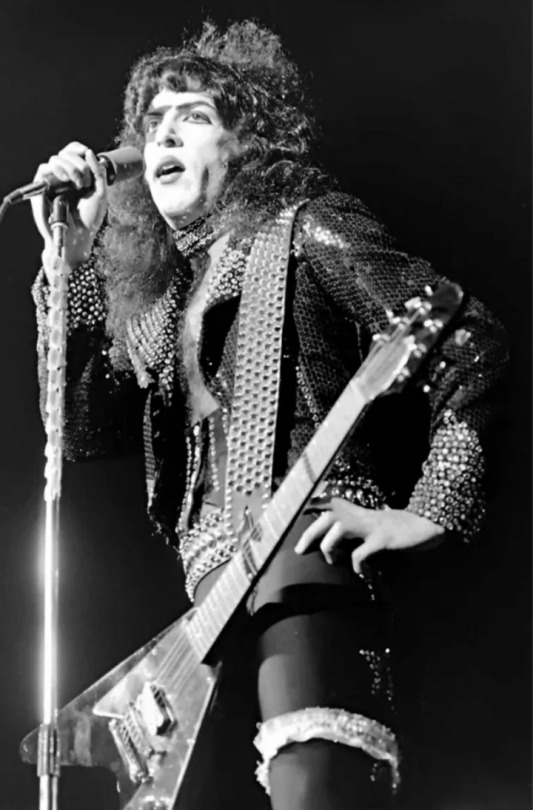


July 24, 1977
Love Gun Tour
Pacific Coliseum - Vancouver, British Columbia
According to the promoter, "The cops heard of KIϟϟ' so-called reputation and they ordered four squads to the show. They played poker all night and billed us $8,000 for overtime" (Montreal Gazette, 8/2/77).
From a local review: "Hype? Not really. KIϟϟ promise nothing less than the greatest spectacle in rock and nothing less is exactly what they provide. From that it is easy for the unaware parent or pundit to mistake KIϟϟ for a threat to our civilized way of life. But understand this, KIϟϟ are not self-pitying, humorless nihilists like the punk rockers. If anything, they are a fantasy for an age that has seen just about everything. Of course they appeal to the escapist stripe. It would be fun to stand seven feet tall, spit fire, deafen everyone within a 1,000 yard radius and make a million bucks doing it" (Vancouver Sun, 7/25/77).
From another local review: "The KIϟϟ concert Sunday night was better than the fireworks display the Sea Festival holds annually. The Coliseum took on all the aspects of kid's day at the PNE's Playland with harried parents leading offspring by the hand up into the stands, plopping their plump selves down into the same seats they had at The Ice Capades or The Shriner Circus, and stopping up their ears with cotton... KIϟϟ was perfunctory as you please, well rehearsed, but musically deadening and the sound from the press box was, as usual, muddy except when Ace Frehley took off into one of his solos. Frehley appeared to be bored, or tired, or sick, or drunk, or all four, while batman, Gene Simmons and Paul Stanley did their best to whip up a surprisingly complacent audience which eventually succumbed and went nuts when the hits and the gimmickry got into gear" (Georgia Straight, 7/28/77).
#kisstory#kiss#1977#love gun#ace frehley#peter criss#paul stanley#gene simmons#kiss band#kiss army#the spaceman#the starchild#the catman#the demon
42 notes
·
View notes
Photo
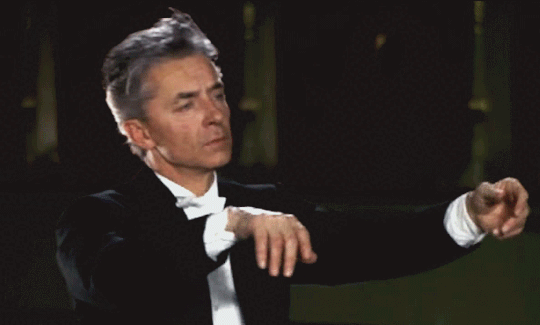
Those who have achieved all their aims probably set them too low.
- Herbert von Karajan
The Soprano Christa Ludwig described him as ‘Le bon Dieu’, while scores of musicians, reviewers and listeners have long regarded him as simply untouchable in the art of conducting. There was, however, much about Herbert von Karajan that was distinctly ungodlike. Ruthlessly ambitious as a young man and grimly autocratic in his later years, his life story is marked by bitter rivalries, feuds and, most notoriously, membership of the Nazi party.
But then, just listen to the results. It’s fascinating to look at the career, the controversy and the achievements of a conductor who still intrigues fans and detractors like no other musician long after his death.
The early career of Herbert von Karajan continues to be swathed in controversy.
Was he an ardent Nazi or an ambitious opportunist? If he was a zealous party member, should we revere his recordings as much as we do? To what extent should any moral accountability weigh against Karajan’s musical achievement? And how much latitude can we extend to people who have artistically given so generously?
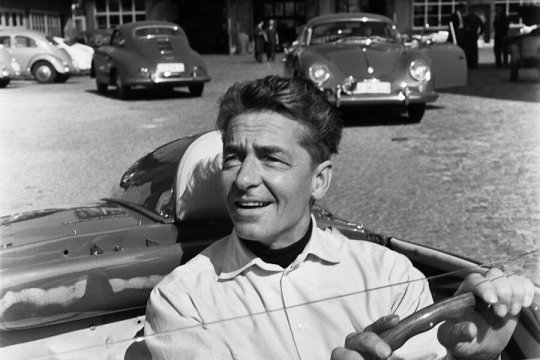
Karajan is not alone in occupying this uncomfortable situation during this era. Similar debate surrounds Richard Strauss, Carl Orff and Karl Böhm. Indeed, Wagner also evokes hostility in certain quarters with regard to his racial sentiments.
When Adolf Hitler swept to power in January 1933, the 24-year-old Austrian Herbert von Karajan had already notched up nearly four seasons as an up-and-coming opera conductor in the South German city of Ulm.
Born in Salzburg in 1908 into a prosperous family, he had demonstrated gifts as a pianist and conductor while studying in Vienna. After graduation, his debut orchestral concert with the Salzburg Mozarteum Orchestra in January 1929, featuring works by R Strauss, Mozart and Tchaikovsky, caused a local sensation and helped to secure him the contract in Ulm.
Karajan seized on the opportunity to learn his trade in Ulm and cut his teeth on much of the operatic repertory from Mozart and Beethoven to Puccini and R . Strauss, including the opera Schwanda der Dudelsacker by the Czech Jewish composer Jaromir Weinberger.
Yet, after the Nazi take-over, Karajan’s future wasn’t assured.
In early 1933, German operatic life was thrown into turmoil as the regime hounded out musicians that were deemed politically and racially unacceptable, and also pursued a protectionist policy to limit employment for non-Germans.
Against this context, Karajan’s decision to join the Nazi Party in Salzburg in April 1933 should be understood as an opportunistic move which was probably designed to safeguard his position at Ulm. Whether it also signalled enthusiasm for Nazi policy is open to speculation, though he no doubt hoped that the strong-arm methods of the Nazis would bring cultural stability to Germany.
Karajan retained his Ulm job for a further season, during which he expanded his repertory to include a praised account of Strauss’s opera Arabella. But in March 1934 he was fired for professional intrigue involving a potential Jewish rival.
He did not have to wait long for a new post. Three months later he was made general music director in Aachen.
Working in a larger theatre enabled Karajan to tackle more ambitious repertory, such as Wagner’s Ring cycle, Verdi’s Otello and Strauss’s Elektra. He also consolidated his reputation in the concert hall, taking charge of Aachen’s annual season of orchestral and choral concerts. One pre-condition for accepting was that he should re-apply for membership of the Nazi Party, his earlier membership in Salzburg having lapsed. This was confirmed in March 1935.

Although in his denazification trial in March 1946 Karajan argued that he had joined the Party to further his career, he could not escape his obligation as Aachen’s general music director to provide the musical background for political occasions.
On 29 June 1935 he took part in a huge open-air orchestral and choral concert that celebrated the NSDAP Party Day and at a similar ceremony four years later he conducted the close from Wagner’s Meistersinger. But his concert programmes seemed untainted by political interference – works by Debussy, Ravel, Kodály and Stravinsky rubbed shoulders with German ones. In 1938 he flouted the law by programming Dukas’s Sorcerer’s Apprentice. Party authorities must have overlooked that Dukas was of Jewish descent.
Karajan conducts Dvořák’s “New World” Symphony No. 9, performed by the Vienna Philharmonic Orchestra
By 1937 Karajan’s achievements in Aachen were attracting national interest.
In a special edition devoted to Germany’s conducting legacy, the journal Die Musik singled him out as a man who ‘can lead the new organisation of our cultural life in the spirit and direction which National Socialism demands’. Concert engagements in Gothenburg, Vienna, Amsterdam, Brussels and Stockholm helped to spread his name beyond Germany.
Yet for all this, Karajan set his sights even higher by hoping to make an impact in Berlin. This ambition was realised in 1938 with a ‘Strength through Joy’ concert with the Berlin Philharmonic and engagement as conductor at the Berlin State Opera in Wagner’s Tristan und Isolde in October of the same year.
Karajan may not have anticipated that with his move to Berlin he was stepping into a political cauldron over which he would have little control.
It began with a review of his Tristan which appeared in the Berliner Zeitung. Under the title ‘Karajan the Miracle’, the critic Edwin von der Nüll lavished praise on the performance suggesting that in conducting Wagner’s score from memory the 30-year-old conductor had achieved ‘something our great men in their fifties might envy’.
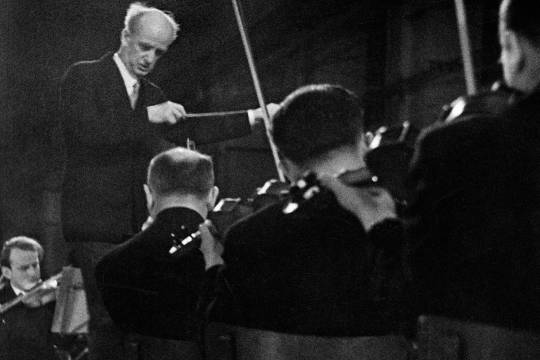
This was calculated to offend the conductor Wilhelm Furtwängler who had previously ruled the roost in the same theatre. Karajan was set up as a pawn in the struggle for control of Berlin’s cultural institutions between Propaganda Minister Joseph Goebbels, a Furtwängler supporter, and Minister of Interior Hermann Goering, the patron of the Berlin State Opera.
In June 1939 Karajan conducted Wagner’s Die Meistersinger at the State Opera without a score. The performance collapsed when the baritone, a drunk Rudolf Bockelmann, made a serious error. Alas Hitler, in the audience, was furious, blaming instead Karajan’s insufficiently Germanic approach to Wagner by conducting from memory.
Further problems arose over his marriage in 1942 to the quarter Jewish Anita Gütermann, technically against the law.
Yet, despite this and the continuing hostility and suspicion of Goebbels and Hitler and Furtwängler’s jealousy, his career prospered during the war. He conducted Bach’s B Minor Mass in Paris for the occupying German soldiers in 1940 and returned to the French capital in 1941 to present his performance of Tristan with the Berlin State Opera.
From 1940 he appeared in Italy and gave concerts in Romania and Hungary. A major achievement was to secure popularity for Orff’s Carmina Burana, a score that had aroused some hostility from the Nazi hierarchy at its first performance in 1937 before Karajan’s performances in Aachen and Berlin during the early 1940s.
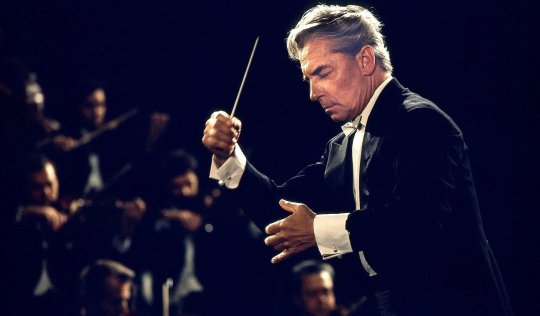
Driven by a fanatical love of music and a desire to advance his career, there’s little doubt that Karajan’s involvement with the Nazi regime was opportunistic.
Doubtless though there were also areas of Nazi policy that may well have chimed in with his own views. At the same time falling foul of the regime on occasions, his personal ideology can be best described as a montage of greys; nothing is ever clear-cut and nor perhaps should be our assessment of his work.
#karajan#herbert von karajan#quote#conductor#music#german#nazi germany#nazism#opera#orchestra#classical music#history#arts#culture
37 notes
·
View notes
Photo
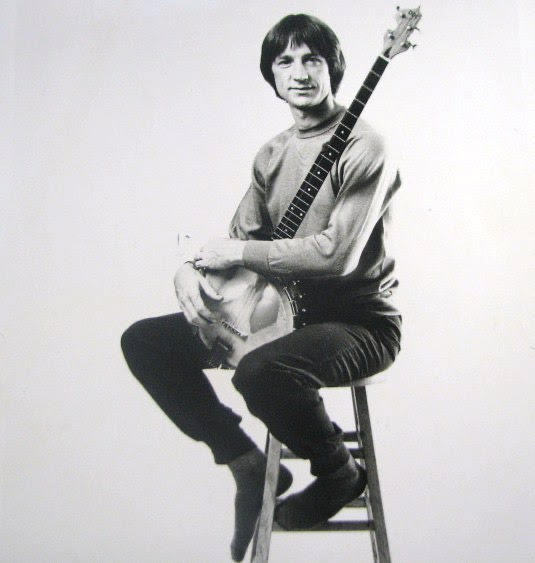

Peter Tork, early 1980s (photo 2 taken in Japan).
“In addition to the [Studio 19] club shows, Tork and his band will play Sunday night [March 21, 1982] at Peaches Records in Clearwater at 6:30, 7:30 and 8:30 p.m. The Peaches shows were added because many of Tork’s fans are too young to be admitted into the club, said a spokesman for Studio 19.” - The Tampa Tribune, March 19, 1982
“Last weekend in Clearwater, Tork and his new band, The New Monks, broke up. Until then, his latest comeback attempt had been rolling along smoothly during the last 18 months. […] The breakup resulted from poor attendance at two Studio 19 concerts, an abruptly canceled canceled gig last Sunday and a flare-up resulting from an on-going friction between band and management, Tork said earlier this week. ‘It was the culmination of a long, slow descent,’ he explained. ‘It’s been a struggle. I thought things had been getting better.’ However, drummer Vince Barranco recently said that the band’s split-up is not final, just in limbo, pending working out problems with management. ‘Oh, it’s further out than limbo,’ Tork said. ‘The band is not intact, and not functioning.’ Calling from a pay phone at a YMCA in New York City, where he works out regularly, Tork said his trip to Florida, which coincided with the annual Monkees Fan Club Convention last week in Largo, has left him in less-than-enviable financial shape.
He said the band members claim they did not get paid for the Clearwater concerts. ‘I’m broke,’ he said flatly. ‘I cannot buy a sandwich. Well, I can, but it’ll stop me from eating for two days.’ Tork said only bass player Paul Ill has served official notice of quitting the band. The rest are ‘not too anxious to get back to work,’ he said. Barranco, pianist Tom Myers and guitarist Phil Simon remained in Clearwater last week waiting to get paid for last weekend’s concerts from the promoter, Barranco said, adding that the break-up is not based on personal hostilities. ‘Peter’s a nice guy and all,’ Barranco said. ‘It’s strictly business. ‘I’m game (to rejoin) if everything’s comfortable,’ he said, noting relations between management and band members would first have to be cleared up. […] ‘When I left the Monkees, I found that I was not grounded,’ [Tork] said, referring to his lack of dues-paying and basic music industry know-how. ‘I wanted to learn the trade from the bottom to the top. In California, you can’t do that — there’s no middle ground.’ The small turnout at the Clearwater shows made him question his career direction. ‘I asked myself, “Do I not draw?” Maybe I overplayed my own value,’ he mused, ‘or maybe it’s Reaganomics.’ Due to cost of traveling, The New Monks have been giving small, well-received performances only in Boston, New Jersey and New York, shows featuring Tork on banjo and guitar. […] ‘Some reviews said “don’t do any Monkees material,“ some said “do only Monkees material,”’ Tork said. ‘We decided to call our own shots, but we don’t have enough consistency or experience.’’ […] [During Monkeemania] separating the musicians from the characters on the show was almost impossible. Cast as the dunce, Tork’s character undermined his formidable musical talent. ‘The Peter Tork character reached a lot of people,‘ he said. ‘He was an outcast — he lurched around, not getting hurt by his own bumbling idiocy.’ The character had a built-in protection system — that dumbfounded, naive look — that appealed to everyone, he said. One of Tork’s fondest Monkee memories came during a break in the filming for the pilot of their first TV episode, in which they had been pretending to play instruments. ‘We got them to give us power in the amps and we just started playing,’ he recalled, ‘and everybody started dancing.’ However, Tork is most proud of the second stage [of Monkees history], circa 1967. On ‘Headquarters,’ their third album, the group, for the first time, played almost all of the instruments. Other personal favorites from that period include ‘Pleasant Valley Sunday’ and ‘Goin’ Down,’ a one-take jam released only on the flip side of ‘Daydream Believer.
’ […] [I]n 1978, Tork started easing back into show business, circulating his picture in hopes of landing a spot on a sit-com but drawing few offers.
After a brief stint as a strictly oldies act, he founded The New Monks, ‘and now here I am, broke in New York City,’ he said. But the 38-year-old [sic] singer is far from calling it quits. ‘I’m going to keep plugging,‘ he vowed. ‘I’m not done — this is my craft, my trade.’” - The Tampa Tribune, March 27, 1982
#Peter Tork#Tork quotes#The New Monks#80s Tork#The Monkees#Monkees#Peter deserved better#long read#'I'm going to keep plugging'#so much respect for PT#Headquarters#et al#<3#been typing up a lot of interviews/articles so long reads will be frequent#love his mind#1981#1982#Tork reviews#The Tampa Tribune#can you queue it
26 notes
·
View notes